Services

Oral Surgery is the branch of dentistry concerned with surgical management of relevant conditions affecting the oral cavity. Most commonly this includes surgical treatment of impacted teeth, full clearance, bone grafting and dental implant placement.
Otolaryngology Head & Neck Surgery
This branch of surgery deals with diagnosis and treatment of disorders of the Head and Neck. As well as General Otolaryngology (also known as Ear Nose and Throat Surgery), there are a number of subspecialty areas:
- Otology (ear surgery)
- Rhinology (surgery of the nose and sinuses)
- Laryngology (disorders of the voice / larynx)
- Head and Neck Surgery (management of benign and malignant tumours of the head and neck, including skin and thyroid cancers)
- Facial Plastic Surgery (cosmetic surgery of the face and neck, skin cancer excision and reconstruction, management of facial trauma and congenital conditions).
- Paediatric Otolaryngology (ear, nose and throat conditions in children)
Plastic & Reconstructive Surgery
Plastic & Reconstructive Surgery is the surgical specialty concerned with the "correction" or restoration of form and function. It is often simply called Plastic Surgery. Plastic Surgery has been recognized as a surgical sub-specialty for 100 years. The early advances in the specialty occurred during World War I and II through the need to manage vast numbers soft tissue and bony injures. Subsequent evolution was facilitated by the development of the Operating Microscope and an improved understanding of anatomy.
Cosmetic or aesthetic surgery is the best-publicised kind of plastic surgery but it is not the most common surgery done by Plastic Surgeons. The cosmetic appearance is an important consideration following any operation however the primary concern is often the treatment of skin cancer, trauma (e.g. burns, hand injuries, scars) or reconstruction of a region of the body following cancer treatment (e.g. breast reconstruction).
Plastic Surgeons treat children for congenital abnormalities such as prominent ears, skin (e.g. congential naevi) and hand abnormalities (e.g. syndactyly, polydactyly). Plastic Surgeons also undertake most types of hand surgery (e.g. carpal tunnel, Dupuytren’s disease, ganglions, tendon and nerve surgery).
Plastic Surgeons operate on people of all ages, all parts of the body and for many different reasons.


